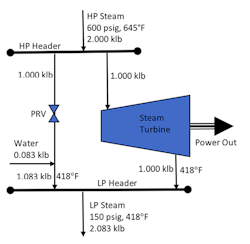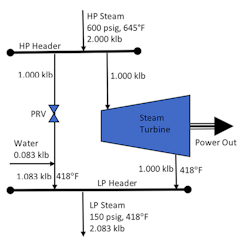Estimating the value of energy savings is essential in the screening of projects (see March 2021’s column, “Screen Your Energy Projects”), and simplified calculations often are the first step. One important, but often misunderstood example of this is the use of simplified “marginal costs” for steam, i.e., the incremental cost of providing or eliminating one unit of steam production (often expressed in $/klb).
Figure 1. Steam passes through a pressure reducing valve in parallel with the turbine to offset electricity imported from the grid.
Most large chemical plants and oil refineries use steam turbines in a simple form of cogeneration (“Double Up on Cogeneration,” May 2020). High-pressure (HP) steam enters a turbine. Passage through the turbine reduces it to low-pressure (LP) steam. Some of the thermal energy in the steam is converted into mechanical energy, which can be used either to drive process equipment (a pump or a compressor), or to generate electricity. The power delivered by turbines offsets electricity that would otherwise come from the grid. This decreases the site’s electric bill, which lowers the effective cost of the LP steam. Typically, some steam also passes through a pressure reducing valve (PRV) in parallel with the turbine, and desuperheating water is added for temperature control (Figure 1).
The following simplified example, based on the material balance in the figure, considers only the two largest cost components — fuel burned in the boiler ($5.00/MMBtu), and imported electricity ($0.05/kWh). We produce HP steam (600 psig, 645°F) from boiler feedwater at 225°F. We need LP steam at 150 psig, 418°F. We created the material balance using additional data from steam tables, based on 2 klb of HP steam, split equally between a steam turbine and a PRV. The boiler fires 1,316 Btu of fuel/lb of HP steam produced. The steam turbine/generator produces 25 kWh of electricity per klb of steam. The desuperheater requires 0.083 klb of water per klb of incoming steam.
Based on this information, Table 1 shows marginal costs and credits.
The LP steam from the turbine is cheaper than the HP steam due to the power credit. However, the marginal cost of the LP steam from the PRV/desuperheater route is also less than the cost of the HP steam — in this case because of the additional flow due to the desuperheating water. This fact often is missed; it can lead to significant errors when calculating the value of steam savings.
Simple marginal steam costs are useful for quick scoping calculations. However, you can include other factors for more accurate calculations — e.g., make-up water and chemicals, energy for pumping and boiler fans, steam consumption for deaeration, heat losses from piping and equipment, and mechanical and electrical losses in steam turbines and generators.
Table 1. Not factoring in desuperheating water can lead to significant errors when calculating the value of steam savings.
More detailed calculations, with rigorous heat and material balances and all significant cost components, are best carried out with modeling tools (see “Homemade Spreadsheets Aren’t Enough,” August 2019). Additional factors to consider depend on whether the steam turbine is coupled directly to plant equipment or to a generator to produce electricity.
Additional information:
Alan Rossiter & Beth Jones, Energy Management and Efficiency for the Process Industries, AIChE/John Wiley & Sons, Inc., Hoboken, New Jersey, 2015, Chapter 17.
About the Author

Alan Rossiter
Energy Columnist
Alan Rossiter is a former contributor for Chemical Processing's Energy Saver column. He has more than 35 years of experience in process engineering and management, including eight years in plant technical support, design and research with Imperial Chemical Industries (ICI, United Kingdom) and nine years in energy efficiency and waste minimization consulting with Linnhoff March, before starting his own business. In 2019 he joined the University of Houston as Executive Director, External Relations for UH Energy. He is a chartered engineer (U.K.) and a registered professional engineer in the state of Texas. His latest book, Energy Management and Efficiency for the Process Industries, coauthored with Beth Jones, was published by John Wiley & Sons in 2015. He is a Fellow of the American Institute of Chemical Engineers and a Past Chair of the South Texas Section of the AIChE.


